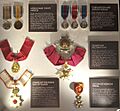Hugh Sinclair facts for kids
Quick facts for kids Admiral SirHugh Sinclair KCB |
|
|---|---|

Sinclair in a carriage in Tallinn
|
|
| Allegiance | United Kingdom |
| Service | Secret Intelligence Service (SIS/MI6) |
| Active | 1923–1939 |
| Rank | Chief of the Secret Intelligence Service |
|
|
|
| Born | 18 August 1873 Southampton, Hampshire, England |
| Died | 4 November 1939 (aged 66) London, England |
| Occupation | Intelligence officer |
Sir Hugh Francis Paget Sinclair (born August 18, 1873 – died November 4, 1939) was a very important British intelligence officer. He was also known as Quex Sinclair. He helped create two of Britain's most secret organizations: the Secret Intelligence Service (SIS), also known as MI6, and GCHQ. These groups work to protect the country by gathering secret information.
Contents
Hugh Sinclair went to Stubbington House School. When he was 13, on July 15, 1886, he joined the Royal Navy as a cadet. He worked hard and became a lieutenant by December 31, 1894.
During the First World War, he joined the Naval Intelligence Division. This group gathered information about other navies. In February 1919, he became the head of this division. He also led the Submarine Service in 1921.
Leading British Intelligence
In 1923, Hugh Sinclair became the second director of the Secret Intelligence Service (SIS). This is Britain's foreign intelligence agency. It collects information from other countries. He was promoted to vice-admiral in 1926 and full admiral in 1930.
Sinclair also helped start the Government Code and Cypher School (GC&CS) in 1919. This group later became known as GCHQ. GCHQ is now famous for its work in code-breaking and electronic intelligence.
Protecting Britain from Threats
From 1919, Sinclair tried to combine MI5, Britain's domestic intelligence agency, with SIS. He wanted to make Britain's efforts stronger against a political idea called Bolshevism. However, this idea was not approved in 1925.
During the years between the two World Wars, SIS was small and didn't have much money. By 1936, Sinclair realized that the Gestapo, which was Nazi Germany's secret police, had found out about some SIS operations. To fix this, he created a secret network called the Z Organization. This group was meant to work separately from the main SIS.
Preparing for World War II
In 1938, as another big war seemed likely, Sinclair set up Section D. This special section was focused on planning secret actions like sabotage.
In the spring of 1938, Sinclair bought a large country house called Bletchley Park. He used his own money, about £6,000, to buy it. He planned for Bletchley Park to be a secret intelligence center during the war. It later became famous for breaking enemy codes.
In December 1938, Sinclair was asked to write a secret report about Adolf Hitler. This report was for important British leaders like Lord Halifax and Prime Minister Neville Chamberlain. Sinclair described Hitler as a person with "fanaticism, mysticism, ruthlessness, cunning, vanity, moods of exaltation and depression, fits of bitter and self-righteous resentment; and what can only be termed a streak of madness; but with it all there is a great tenacity of purpose." Some officials didn't like this report because it didn't fit with Britain's policy of trying to avoid war through "appeasement."
Later Life and Death
Sinclair became very ill with cancer. On October 19, 1939, a friend noted that he was "going downhill." He had an operation on October 29 but sadly died on November 4, 1939, at the age of 66. This was just five days before a famous event called the Venlo incident.
Awards and Decorations
Hugh Sinclair received several important awards for his service:
- 1911 King George V Coronation Medal
- 1916 Companion of the Order of the Bath
- 1918 3rd Class, Order of the Rising Sun (from Japan)
- 1918 Officer, the Legion of Honour (from France)
- 1935 Knight Commander, the Order of the Bath
- 1937 King George VI Coronation Medal
Images for kids



